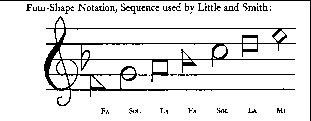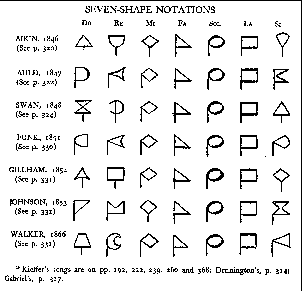What are the Shapes and Why?
by Keith Willard
first published in Prairie Harmony, Volume 2, #1, January 1991used by permission of author
The singing of syllables (solmization) to teach students scales & intervals is usually credited to Guido d' Arezzo (11th century, a six syllable system ut, re, mi, fa, sol, la). In England, by Elizabethan times, this system became simplified to four syllables fa, sol, la, and mi.
A singer would be taught to associate the singing of a given syllable with a particular scale degree. For example the major scale would be sung (while singing the syllables) fa, sol, la, fa, sol, la, mi, fa. This technique was transplanted from Great Britain to colonial America long before any change occurred in the conventional roundhead music notation.
The four shape note system used in the Sacred Harp came into being during a whirlwind of American invention. Nothing and no institution was above diddling. This particular shape system was but part of an endless tinkering with music notation that 18th and 19th century Americans indulged in. Little and Smith with the Easy Instructor invented and patented of the four shape note system, but it was but the latest in a long line of experimental music notations . [sidebar on why experiment]
 figure from p14 White Spirituals in the Southern Uplands
figure from p14 White Spirituals in the Southern Uplands
This notation reform which combined music notation with solmization practice ignited the oblong shaped note tunebook golden era (1801 - Civil War). Books such as Repository of Sacred Music, Kentucky Harmony, Southern Harmony, Sacred Harp, Hesperian Harp, and Social Harp were just some of the dozens produced during this era.
Then came the ominous cloud of the "Better Music Movement." With this movement came the do re mi fa sol la ti do solmization system which had long replaced the simpler fasola system in Europe among the musically literate. In the urban north the victory of Mason and his ilk was complete with the eradication from the churches and communities of such scourges as the "patent" notes and the "crude music" of composers such as William Billings.
The south was far more resilent in preserving their ways. But even here the long arm of this movement was felt, and thus the seven shaped note system was born. With the exception of the editors of a handful of books Southern shaped note tune compilers largerly accepted the belief that the seven syllable ("one for each note") solmization was superior to the old fashioned fasola approach. Chief among those leading the charge to this trough was "singing Billy Walker" (compiler of the four shape Southern Harmony) with his Christian Harmony. Although a variety of seven shape notations were invented, the emerging standard was created by Jesse Aiken.
 figure from p337 White Spirituals in the Southern Uplands
figure from p337 White Spirituals in the Southern Uplands
Through his personal presence and intimidation tactics he gradually bludgeoned music publishers into agreements acknowledging his notation standard. Other notable books published in this format were Harp of Columbia (and the New Harp of Columbia), Harmonia Sacra.
During the era of late 19th century and the first few decades of the 20th century legions of seven shaped small books were published in southern book mills. The music published in these books were mostly gospel and revival tunes. The people singing this music had a raging thirst for the new and according to GP Jackson, it was not uncommon for singers at a seven shape singing convention to show up and sing out of a book just published and never before seen by any of the singers. With the coming of modernity to the rural south this vigorous flood of music publishing dwindled, and currently there exists only a few seven shaped tune books still in publication.
Whither goest shape note notation? Today we sing less as a society than ever before. Perhaps the reintroduction of the modest ideas of Little and Smith into our elementary (and college music programs!) music curricula could start us on the pathway of the original goals of the Better Music movement--to sing better and sing more. And if some of the"old music" slips in along the way who would complain?